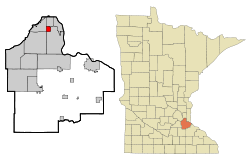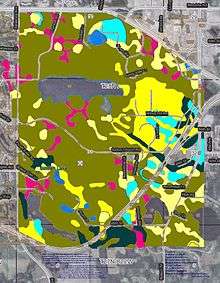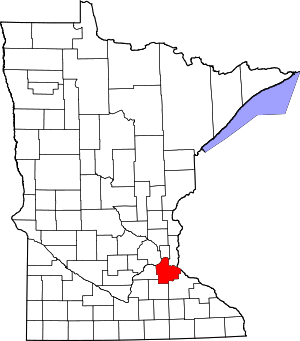Sunfish Lake, Minnesota
Sunfish Lake is a city in Dakota County, Minnesota, United States. The population was 521 at the 2010 census.[6] First incorporated as a village in 1958, the city's goal has been to maintain a rural atmosphere, with large lot size and as little disturbance of the natural environment as possible.
Sunfish Lake | |
|---|---|
 Location of the city of Sunfish Lake within Dakota County, Minnesota | |
| Coordinates: 44°52′2″N 93°5′49″W | |
| Country | United States |
| State | Minnesota |
| County | Dakota |
| Area | |
| • Total | 1.67 sq mi (4.32 km2) |
| • Land | 1.50 sq mi (3.88 km2) |
| • Water | 0.17 sq mi (0.43 km2) |
| Elevation | 971 ft (296 m) |
| Population | |
| • Total | 521 |
| • Estimate (2019)[3] | 544 |
| • Density | 362.91/sq mi (140.11/km2) |
| Time zone | UTC-6 (Central (CST)) |
| • Summer (DST) | UTC-5 (CDT) |
| ZIP codes | 55077, 55118 |
| Area code(s) | 651 |
| FIPS code | 27-63544[4] |
| GNIS feature ID | 0652818[5] |
| Website | www.sunfishlake.org |
Geography and native vegetation

According to the United States Census Bureau, the city has a total area of 1.69 square miles (4.38 km2), of which 1.52 square miles (3.94 km2) is land and 0.17 square miles (0.44 km2) is water.[7]
The city is bordered by Highways 62 to the north, 3 to the east, 60th Street West/Peiper Road to the south and Delaware Avenue to the west. I-494 runs through the city with an exit at 3.
Native vegetation based on NRCS soils information shows approximately two thirds forest soils (light blue, green and dark green), less than 10% savanna soils (red and red with blue stripes) and about 20% prairie (yellow) and wet prairie (light yellow). Most of the city is heavily wooded, on moraine topography with many slopes and wetlands and three small private lakes – Hornbeam Lake, Horseshoe Lake, and the eponymous Sunfish Lake, which was formerly known as Lake Thereau by the early French settlers of the area. For new construction, the minimum lot size is 2.5 acres (10,000 m2) of buildable land to keep with the city's goal of maintaining a rural atmosphere.
Demographics
| Historical population | |||
|---|---|---|---|
| Census | Pop. | %± | |
| 1960 | 181 | — | |
| 1970 | 269 | 48.6% | |
| 1980 | 344 | 27.9% | |
| 1990 | 413 | 20.1% | |
| 2000 | 504 | 22.0% | |
| 2010 | 521 | 3.4% | |
| Est. 2019 | 544 | [3] | 4.4% |
| U.S. Decennial Census[8] | |||
Sunfish Lake is one of the wealthiest towns in America.
2010 census
As of the census[2] of 2010, there were 521 people, 183 households, and 158 families living in the city. The population density was 342.8 inhabitants per square mile (132.4/km2). There were 194 housing units at an average density of 127.6 per square mile (49.3/km2). The racial makeup of the city was 94.4% White, 1.2% African American, 2.3% Asian, 0.6% from other races, and 1.5% from two or more races. Hispanic or Latino of any race were 4.8% of the population.
There were 183 households, of which 36.1% had children under the age of 18 living with them, 78.1% were married couples living together, 3.8% had a female householder with no husband present, 4.4% had a male householder with no wife present, and 13.7% were non-families. 12.0% of all households were made up of individuals, and 4.9% had someone living alone who was 65 years of age or older. The average household size was 2.85 and the average family size was 3.09.
The median age in the city was 48 years. 25.9% of residents were under the age of 18; 6.8% were between the ages of 18 and 24; 12.5% were from 25 to 44; 38.7% were from 45 to 64; and 16.1% were 65 years of age or older. The gender makeup of the city was 49.9% male and 50.1% female.
2000 census
As of the census[4] of 2000, there were 504 people, 173 households, and 147 families living in the city. The population density was 319.0 people per square mile (123.2/km2). There were 178 housing units at an average density of 112.7 per square mile (43.5/km2). The racial makeup of the city was 96.83% White, 2.58% Asian, and 0.60% from two or more races. Hispanic or Latino of any race were 2.78% of the population.
There were 173 households, out of which 42.2% had children under the age of 18 living with them, 78.0% were married couples living together, 5.2% had a female householder with no husband present, and 15.0% were non-families. 13.3% of all households were made up of individuals, and 6.9% had someone living alone who was 65 years of age or older. The average household size was 2.91 and the average family size was 3.20.
In the city, the population was spread out, with 30.0% under the age of 18, 4.4% from 18 to 24, 19.2% from 25 to 44, 32.1% from 45 to 64, and 14.3% who were 65 years of age or older. The median age was 43 years. For every 100 females, there were 90.9 males. For every 100 females age 18 and over, there were 91.8 males.
The median income for a household in the city was $148,410, and the median income for a family was $161,491. Males had a median income of $100,000 versus $55,714 for females. The per capita income for the city was $82,347. About 0.7% of families and 2.4% of the population were below the poverty line, including 1.4% of those under age 18 and 7.1% of those age 65 or over.
City government
City government is simple: there are no city employees and no direct city services. Consultants provides the necessary professional services. Contractual arrangements with neighboring cities cover police and fire protection. Roads are maintained by independent contractors. All but a few properties have water wells and individual septic systems.
Deer problem
Sunfish Lake is said to have over 50 deer contained within its 1.7-square-mile (4.4 km2) area. Deer are known to be a nuisance especially in causing traffic problems, but can also cause damage to private property by consuming natural and planted vegetation around homes. Bucks also use small trees and saplings to rub their antlers on in order to remove a velvet like material that covers them. This damages the bark and can eventually completely kill the tree. The City Council enacted a deer culling program in 2009 in an attempt to decrease the population. The hunting was limited to Musser Park but produced only 10 total deer kills. In 2010, the City Council expanded the range of the hunting to willing private owners' land. A team of bowhunters was invited to participate in the deer eradication. This is an opportunity to help the city and also train themselves as bowhunters.
Notable people
- Corbin Lacina, former American football player
- Priscilla Lord Faris, Democratic politician
- Vince Flynn, author
- Joe Mauer, former baseball player for the Minnesota Twins
- Mike McFadden, Republican politician
- T.J. Oshie, professional hockey player.
- John "Ozzie" Nelson, CEO
- obie
References
- "2019 U.S. Gazetteer Files". United States Census Bureau. Retrieved July 26, 2020.
- "U.S. Census website". United States Census Bureau. Retrieved 2012-11-13.
- "Population and Housing Unit Estimates". United States Census Bureau. May 24, 2020. Retrieved May 27, 2020.
- "U.S. Census website". United States Census Bureau. Retrieved 2008-01-31.
- "US Board on Geographic Names". United States Geological Survey. 2007-10-25. Retrieved 2008-01-31.
- "2010 Census Redistricting Data (Public Law 94-171) Summary File". American FactFinder. United States Census Bureau. Retrieved 27 April 2011.
- "US Gazetteer files 2010". United States Census Bureau. Archived from the original on 2012-01-25. Retrieved 2012-11-13.
- "Census of Population and Housing". Census.gov. Retrieved June 4, 2015.
